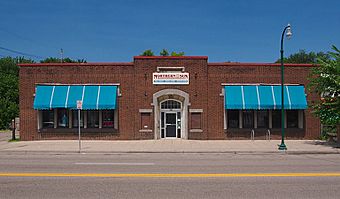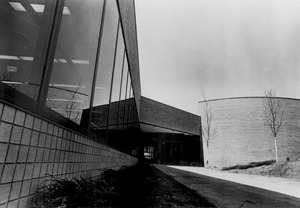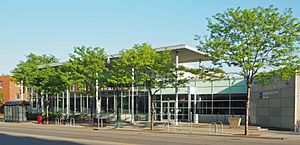East Lake Library facts for kids
East Lake Library is one of the many branch libraries in Minneapolis, Minnesota. It used to be part of the Minneapolis Public Library System and is now part of the larger Hennepin County Library System. Since 1924, three different buildings have been home to this library.
Contents
The First East Lake Library
The very first East Lake Community Library opened its doors in February 1924. It was built between two other libraries, Hosmer and Roosevelt. The Roosevelt Library was even designed to look a lot like East Lake.
Located on Lake Street, the first library had a simple design and a cool skylight. Because it looked a bit like a shop, people sometimes called it a 'Reading Factory'. This library was one of the last ones built during a big period of library construction in Minneapolis, which started in 1905.
The first East Lake Library stayed open until the mid-1970s. By then, more space was needed for all the books and people. In 1974, the library was lending out over 120,000 items each year!
In 1976, the library closed its doors. The building then became a Montessori day care. Later, in 1987, a company called Northern Sun Merchandising bought the building. They still use it today. In 2000, the building was added to the National Register of Historic Places because of its history. In 2004 and 2005, 80 solar panels were put on the roof. You can still see the original library shelves circling the walls inside the building!
The Second East Lake Library
The second East Lake Library was built just two blocks west of the first one. It was much bigger, with about 15,000 square feet of space and 30,000 books. It also had a large meeting room, about 2,390 square feet.
This new building was part of the Minnehaha Mall, which included stores like Target and SuperValu. This helped bring more people and growth to the area. The library served the people in the Longfellow and Phillips neighborhoods very well. It was even the second busiest library in the city, after only Washburn Library. However, by the early 2000s, the building started to show its age.
In 1999, a plan called Outlook Twenty Ten was created. It suggested different ways to update the library:
Option A
This plan suggested adding 6,000 square feet to the building. This would have cost almost $3 million.
Option B
This option proposed an even bigger expansion of 7,000 square feet. It also suggested buying nearby properties. This would give more freedom to design a brand new library building. This plan also would have cost almost $3 million.
Option C
This simple option was just to fix up the library and make a few small changes. No cost was estimated for this plan.
The Third East Lake Library
None of the plans from Outlook Twenty Ten were followed exactly. Instead, on April 30, 2005, the second East Lake Library closed. This made way for a brand new, third building.
The newest East Lake Library was designed to look similar to Minneapolis's Central Library, which was also being built at the same time. The new East Lake building has a modern look with glass and metal on the outside. It was designed by KKE Architects. It was also the first "green branch library" in the Minneapolis Public Library system, meaning it was built to be good for the environment.
The new library opened on March 10, 2007. It has special areas like a teen section and a small business area. It also has cool automated systems for checking out books. You can find it in the same spot as the 1976 building, at 2727 E. Lake Street.
Community Partnerships
East Lake Library works with many groups in the community. One important partnership is with an organization called Learning Dreams. This program started by helping kids with their homework. It grew to include both children and their parents. It offers special learning chances to gain fun and useful knowledge.
Some programs include computer classes for older adults. These classes are offered through a partnership with the Minnesota Board on Aging. The library also helps people look for jobs. Funds from the Neighborhood Revitalization Program helped create a permanent display. This display shows the history of the Longfellow neighborhood with old photos, articles, and books.
Art at the Library
The East Lake Library also has some interesting art. One piece is called Zoomorphy, created by Zoran Mojsilov in 2007. It features large granite rocks held up by curvy steel rods. This artwork weighs 26,000 pounds and is located outside in the rain garden.
When visitors look through the library's outside windows, they can see Janet Lofquist's art piece called Pages. This artwork has etched glass with famous words from books. You can find lines from Dr. Seuss's Cat in the Hat, words from Galileo Galilei, and parts of Miguel de Cervantes's Don Quixote.






